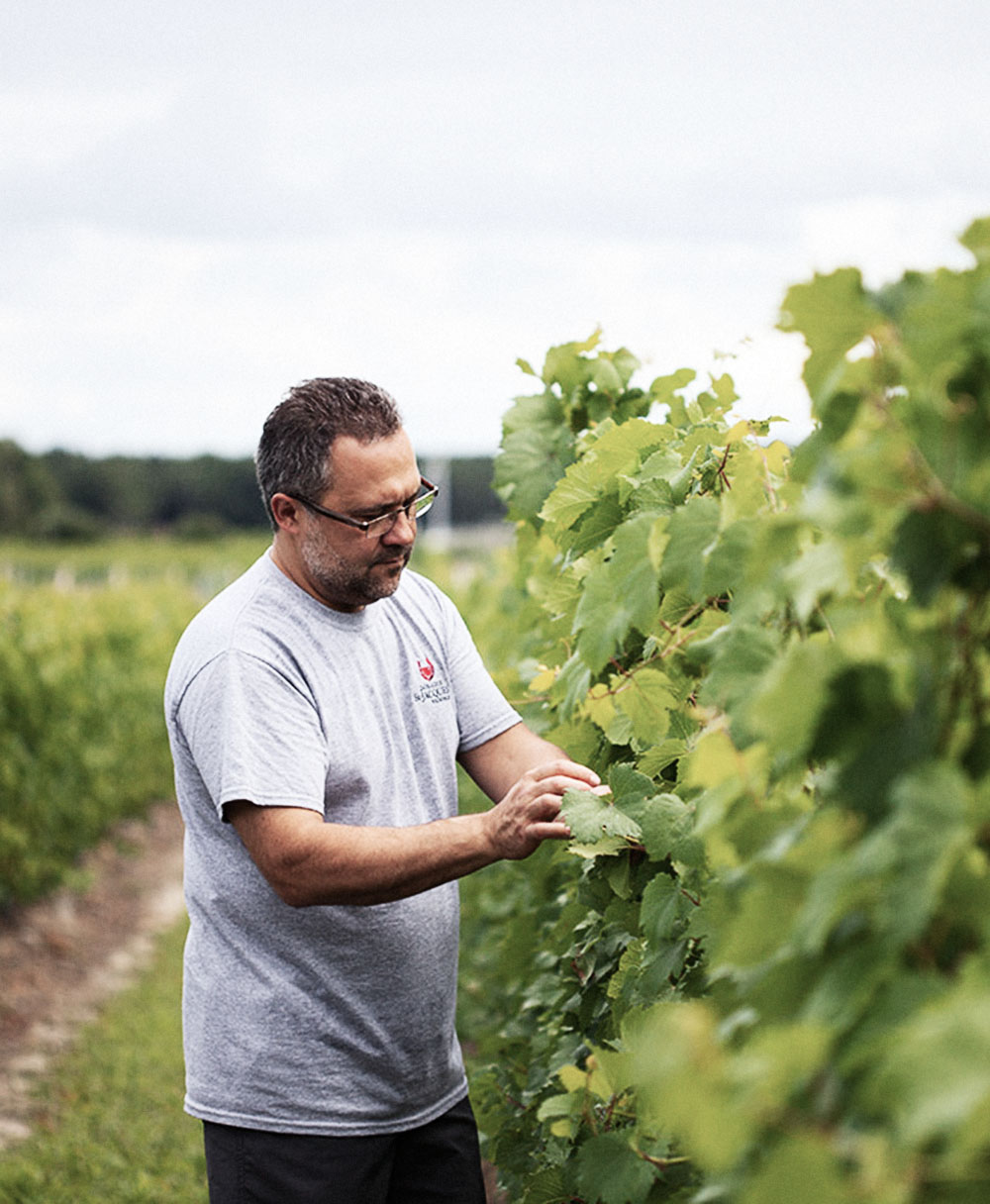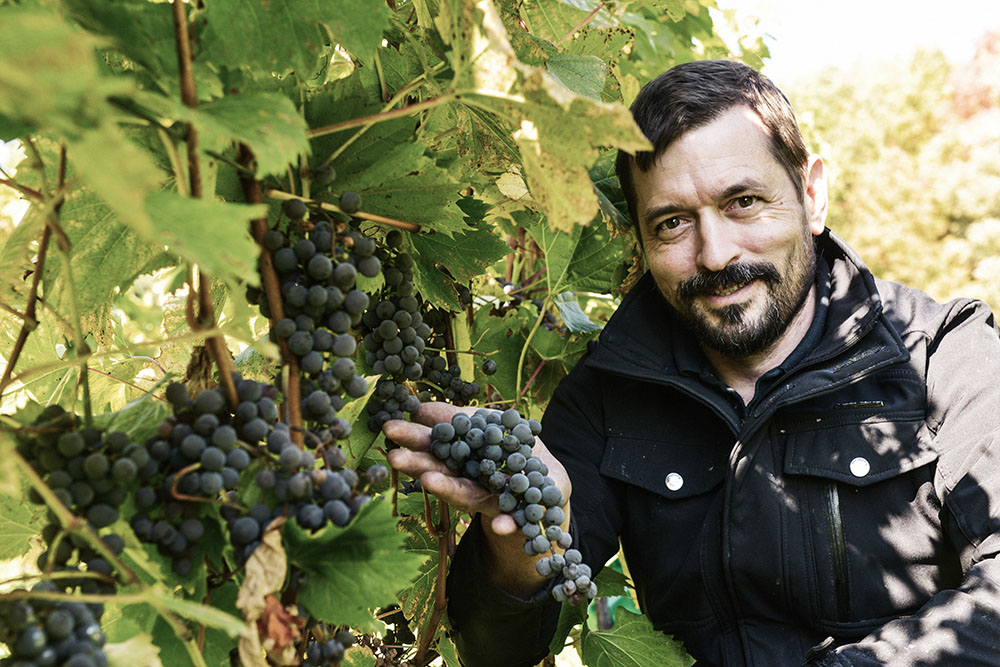It’s the middle of July and I am walking down Rue Racine as wine fills the glasses of festival attendees from Italy, France, the United States and Quebec. It’s the Festival des vins de Saguenay and I come to the booth manned by Yvan Quirion. Yvan is from the Vignoble du Domaine St-Jacques. He is humble, but eager to share his wines. Up until this moment, my knowledge of winemaking in Quebec is that there are some winter-hardy hybrids planted … and that’s pretty much it.

Domaine St-Jacques Pinot Noir 2015 ($25.95)
Aromas of ripe red cherry are layered over a nice earthiness. Flavours match the nose with the earthy note lingering a bit on the finish. The tannin is approachable now, but has enough structure that this should evolve nicely over the next 3–5 years if cellared.
Domaine St-Jacques Reserve Chardonnay 2015 ($23.95)
Bright golden delicious apple and a nice mineral note jump out of the glass front and centre. On the palate, this brings a crisp and refreshing acidity that begs to be paired with shellfish — whether you’re thinking clam pasta or freshly shucked oysters.
We go through the wines that Yvan has brought to the festival. My eyebrow raises when I see that he has a Pinot Gris and a Pinot Noir. My other eyebrow raises when I taste these wines. There is something happening in Quebec.
There are approximately 660 hectares of vines planted in Quebec, of which approximately 33 hectares are vinifera. While it is truly the infancy of a burgeoning wine region, it isn’t the first time that grape growers have attempted to grow European varietals in the province. In the 1980s, growers attempted to plant vinifera and learned quickly that Quebec’s winters are not friendly to the European varietals. The challenges were clear: how to deal with cold winters and a short growing season.
Domaine St-Jacques is located a half hour south of Montreal. They planted their first parcel of vinifera in 2008. Yvan uses geotextile to protect his vines and is convinced that, with the proper technique, he can keep all the vines alive. However, there were growing pains that accompanied using this experimental material and technique. In the first winter after the vines were planted (2008-09), Yvan lost 60 percent of the vines he had planted. Rather than looking at the experiment as a failure, though, he saw that winter as a success because he didn’t lose all of the vines. Keeping the vines alive became an obsession. He replanted his vineyards and by the spring of 2010 not a single vine was lost. Thus, keeping vinifera alive through the Quebecois winter became a very real possibility.
Domaine St-Jacques isn’t the only winery using geotextile in Quebec. Coteau Rougemont is 50 kilometres from Domaine St-Jacques, and east of Montreal’s south shore. I spoke with winemaker Patrick Fournier about the winery. Patrick has been with Coteau Rougemont since they opened their cellar doors in 2010. He explained to me that they went with geotextiles after first experimenting with burying their vines. Since the soil at Coteau Rougemont actually made it impossible to bury the vines, they made the decision to use mulch to hill up on the vines. Bringing in mulch from outside the vineyard introduced a new set of problems, since it brought bacteria and fungi that would then target the vines. Nowadays, winter in the vineyards at Coteau Rougemont sees the emergence of what looks like a small army camp as geotextile is strung over the vineyards so they look like a long row of tents.
Quebec will always be limited by its climate. The south shore of Montreal shares the same latitude as France’s Médoc region — only without the jet stream. So, the growing season here is short. There is enough time to ripen the fruit properly but it’s unlikely you will ever see late-ripening varietals like Cabernet Sauvignon or Merlot.
Being able to make wine is one thing, selling it is another story. Yvan Quirion also acts as president of the Quebec Winegrowers Association (QWA). Once he recognized the potential for winemaking in Quebec, the organization set out to create a standard of quality for the industry. Yvan explained to me that he first approached the Vintners Quality Alliance (VQA) with the hopes of joining but the talks fell apart because the use of hybrid grapes became a sticking point. In Ontario, there are only eight hybrids that are approved for VQA designation.
Instead, the Quebec Certified wine designation was created to identify to consumers that the wines have been grown in the province. The program is overseen by the Conseil des appellations réservées et des termes valorisants (CARTV), an organization created by the Quebec government to help protect the authenticity of provincial products and the terms used to identify and promote them. Similar to VQA, the QC designation means that 100 percent of the grapes in the bottle come from Quebec.

The budding industry has received some support from the SAQ and Coteau Rougemont is on some wine lists in Montreal and Quebec City. However, Yvan still feels the Quebec market hasn’t quite embraced local wine. He believes it will take recognition from outside the province before these wines start to gain the recognition that they deserve.
Both Coteau Rougemont and Domaine St-Jacques were present at the International Cool Climate Chardonnay Celebration hosted in Niagara this past July, so that’s a start. They were welcome additions to an event that featured a strong contingent of Canadian wineries from British Columbia, Ontario and Nova Scotia.
I feel the greatest strength of Quebec wines lies in the value they deliver. The Pinot Noir from Domaine St Jacques is $25 and the Pinot Gris from Coteau Rougemont is $24, and the remainder are priced comparably. Yvan believes that the affordability of these wines will be the key to their success. He doesn’t want the wines to be out of reach for the average consumer in Quebec. There may be plans down the road to make some single-block wines or a high-end reserve, but for now Quebec wineries only care about getting their bottles into the hands of consumers.
What’s next for the wine industry in Quebec?
While most wineries are located south of Montreal, there are also vines planted in the Eastern Townships and near Quebec City — the province’s wine-growing regions have not been clearly defined yet. Patrick believes that we will see focused winemaking develop in different areas — he suggests there might be some specialization for Pinot Noir or sparkling. And more grapes are being planted: Yvan plans to double the amount of vinifera he has planted in his vineyards and Coteau Rougemont is planning to add Pinot Noir and Riesling to their existing plantings.
Coteau Rougemont Pinot Gris 2015 ($24)
There is a nice depth on the nose, with bruised apple and peach and nice mineral poking through. The texture of this wine is nice and weighty on the mid-palate and it fills your mouth from bottom to top … before everything is pulled away clean by nice acidity.
Coteau Rougemont Chardonnay La Côte 2015 ($24)
There is a nice aroma of sponge toffee layered over baked apple. On the palate, this wine opens with fantastic depth and weight filling your mouth with apple and spice. As the wine starts to finish, the fruit is caressed by a vanilla note that lingers for a moment on the finish. The vanilla and spice that lingers is balanced by a nice acidity, so it only sticks around like a polite houseguest before leaving.
